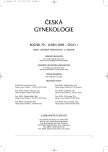Risk Factors of the 3rd and 4th Degree Tear during Delivery
Risk Factors of the 3rd and 4th Degree Tear during Delivery
Objective:
Summary of the mutual relationship between vaginal delivery and anal incontinence.
Design:
Retrospective case-control study.
Setting:
Department of Gynaecology and Obstetrics, Charles University and Faculty Hospital Pilsen, Czech Republic.
Methods:
9600 vaginal deliveries between January 1997 and March 2004 were evaluated. The aim of the study was to observe the incidence of the 3rd degree tear and identification of the risk factors. The recognition of the perineal injury was open to the individual interpretation and assessment of the doctors involved.
Results:
The incidence of the 3rddegree tear was 0.84%. The diagnostics of the 3rd degree tear was significantly more frequent if the evaluation of the perineal injury was performed by the urogynaecologists (p<0.001). Statistically significant risk factors of the 3rd degree tear in the univariate and multivariate analysis were: forceps, shoulder dystocia, the length of the 2nd stage of labour and maternal cooperation at the final phase of delivery. Parturity (primiparity), birth weight and episiotomy (when all types of episiotomy were included) were statistically significant only in the univariate analysis. Mediolateral episiotomy was not proved to be either the risk or the protective significant factor.
Summary:
The diagnostics of the 3rd degree tear demands a detailed knowledge of the structure and anatomy of the pelvic floor. Asufficient amount of experience and erudition are the requirements for the prevention, diagnostics and subsequent treatment of this injury.
Key words:
third degree tear, perineal trauma, delivery, forceps, episiotomy, maternal cooperation
Autoři:
V. Kališ; P. Chaloupka; Jakub Turek
; Z. Rokyta
Působiště autorů:
Gynekologicko-porodnická klinika LF UK a FN, Plzeň, přednosta doc. MUDr. Z. Rokyta, CSc.
Vyšlo v časopise:
Ceska Gynekol 2005; 70(1): 30-36
Kategorie:
Původní práce
Souhrn
Cíl práce:
Shrnutí vzájemného vztahu vaginálního porodu a anální inkontinence.
Typ studie:
Retrospektivní studie.
Název a sídlo pracoviště:
Gynekologicko-porodnická klinika LF UK a FN, Plzeň.
Metodika:
Hodnoceno je 9600 vaginálních porodů mezi roky 1997–2004. Sledována je incidence ruptury perinea 3. stupně a vztah vybraných porodnických faktorů. Hodnocení vlastní diagnostiky poranění.
Výsledky:
Incidence těžké ruptury perinea byla 0,84 %. Incidence ruptury perinea 3. stupně, byla statisticky mnohem častější, pokud byla diagnostika provedena autory studie – urogynekology (p<0,001). Statisticky signifikantní faktory ruptury perinea v unifaktoriální i multifaktoriální analýze byly: forceps, dystokie ramének, délka 2. doby porodní a spolupráce rodičky na konci porodu. Parita (primiparita), porodní hmotnost a celkové hodnocení episiotomií byly statisticky signifikantní jako rizikový faktor v unifaktoriální analýze, ne však v multifaktoriální analýze. Provedení mediolaterální episiotomie signifikantně nezvýšilo ani nesnížilo prevalenci ruptur 3. stupně.
Závěr:
Vlastní diagnostika stupně poranění hráze při porodu vyžaduje detailní znalosti struktury hráze a anatomie pánevního dna. Dostatek zkušeností a erudice jsou předpokladem prevence, diagnostiky a následného ošetření tohoto traumatu.
Klíčová slova:
ruptura hráze 3. stupně, perineální trauma, porod, forceps, episiotomie, spolupráce rodičky
Štítky
Dětská gynekologie Gynekologie a porodnictví Reprodukční medicínaČlánek vyšel v časopise
Česká gynekologie

2005 Číslo 1
- Horní limit denní dávky vitaminu D: Jaké množství je ještě bezpečné?
- Dlouhodobé užívání dienogestu v terapii endometriózy
- Isoprinosin je bezpečný a účinný v léčbě pacientů s akutní respirační virovou infekcí
- Moje zkušenosti s Magnosolvem podávaným pacientům jako profylaxe migrény a u pacientů s diagnostikovanou spazmofilní tetanií i při normomagnezémii - MUDr. Dana Pecharová, neurolog
- Postupné vysazování inhibitorů protonové pumpy
Nejčtenější v tomto čísle
- Abdominální hysterektomie – rizikový faktor vzniku močové inkontinence? Výsledky dotazníkové studie
- Risk Factors of the 3rd and 4th Degree Tear during Delivery
- Syndrom pseudomyxomu peritonea – popis tří případů a přehled problematiky
- Přínos dopplerovského vyšetření pro těhotenství s rizikem alloimunní anémie plodu
